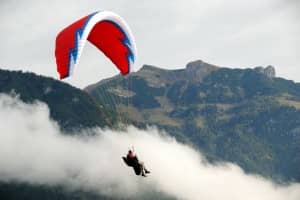 Originally the SIV was scheduled to be at the Gardasee in Italy but due the bad weather in the southern Alps, Nova was able to move the workshop to the Achensee (just north of the Alps). First it did not look very good as the Foehn (Chinook) was building up and we had some gusty and windy conditions in the morning. It still turned out we could do up to 4 flights on Saturday and 3 flights on Sunday, which was very surprising. Walter Holzmuller was running the workshop and did a great job as all the discussions and maneuvers were practice related.The interesting statistics about SIV (Simulated Incidence in flight/Vol) was that trthere is a huge percentage of experienced cross-country pilots (flying at least 10-25 years) have never done a SIV course. It seams like that the biggest percentage of SIV participants are flying for 3-5 year.
The most what I got out of the workshop was the different types of methods to get down to the ground fast.
Here are the different methods:
Originally the SIV was scheduled to be at the Gardasee in Italy but due the bad weather in the southern Alps, Nova was able to move the workshop to the Achensee (just north of the Alps). First it did not look very good as the Foehn (Chinook) was building up and we had some gusty and windy conditions in the morning. It still turned out we could do up to 4 flights on Saturday and 3 flights on Sunday, which was very surprising. Walter Holzmuller was running the workshop and did a great job as all the discussions and maneuvers were practice related.The interesting statistics about SIV (Simulated Incidence in flight/Vol) was that trthere is a huge percentage of experienced cross-country pilots (flying at least 10-25 years) have never done a SIV course. It seams like that the biggest percentage of SIV participants are flying for 3-5 year.
The most what I got out of the workshop was the different types of methods to get down to the ground fast.
Here are the different methods:1] The most common one is "Big Ears". This gets you down with up to 12 m/sec (only with 3 liners, not 2 liners). Keep in mind, going down faster does not mean gaining more ground speed/airspeed, if anything, you are flying slower. A lot of pilots use this method thinking they fly faster to fly away from something, which is not true. "Big Ears" work very well, but can not be used as an overall maneuver to get down. Sometimes it is better to fly away as fast as possible from big lift and then spiral down instead of staying in big lift with "Big Ears".
2] "B-line stall" which is not recommend anymore as it can lead to a "kravatte" and maybe gives you about 12 m/sec sink. Check your manufactures manual, some advice not to fly "B-line stalls" at all.
3] A "deep Spiral" can achieve more then 20 m/sec, but it creates a lot of g-forces and can lead to black outs and can be rough to do in turbulent air.
4] The most interesting maneuver was the 60% asymmetric collapsed spiral dive. With this spiral dive you have less g-forces and a stable decent of more then 25 m/sec in turbulent conditions. I was very surprised to experience how stable and save this spiral is. My big worry was to get into trouble with lines getting caught in the canopy during this maneuver or when stopping it. But based on the experiences the SIV schools had, there are no incidents like that at all. The most important result of this workshop was learning about the asymmetric collapsed spiral dive and to be able to practice it over water.
Thanks again to Walter Holzmuller, Mik Brochard, Toni Bender and Nova to put this on for us.


No comments:
Post a Comment